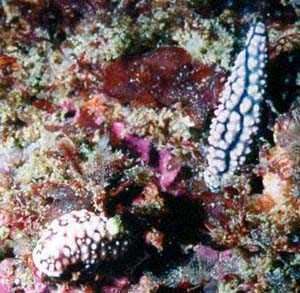A case of mimicry
June 25, 1998
From: Wayne Ellis

Hi Bill,
Here is another of Steve Grail's photos. It was taken off Mooloolaba, Sunshine Coast, southern Queensland, in 10-20m, between 1996 and 1998.
Regards
Wayne Ellis
glaskin@ozemail.com.au
Ellis, W., 1998 (Jun 25) A case of mimicry. [Message in] Sea Slug Forum. Australian Museum, Sydney. Available from http://www.seaslugforum.net/find/82Wayne, The two nudibranchs in Steve's photo are quite unrelated. On the left is Chromodoris geometrica and on the right Phyllidiella pustulosa. During his study on phyllidiids, David Brunckhorst discovered a number of invertebrates which were very similar in shape and colour to phyllidiids. In 1994, Leslie Newman and Lester Cannon (Queensland Museum) described one of these - a remarkable flatworm, Pseudoceros imatatus. The chromodorid Chromodoris geometrica also has a close resemblance to Phyllidiella pustulosa. Phyllidiella pustulosa and its "look-alikes" are probably an example of what we call "mimicry". In most general terms "mimicry" is a process where one or more species evolves to resemble another species (the model) for some biological "gain".
There are many cases amongst butterflies where the colour pattern of a highly distasteful, often poisonous, butterfly is copied by other, quite edible butterflies. Because they have identical or very similar colour patterns, the edible butterflies gain considerable protection from feeding birds who have learnt from experience to leave the distasteful species alone.
In other more complicated examples, groups of unrelated species, sometimes all distasteful, have evolved a similar colour pattern for mutual protection.
In the case of Phyllidiella pustulosa, Chromodoris geometrica and Pseudoceros imatatus we have no direct evidence that these three are mimics and that they are part of a mutual protection system. However there is considerable circumstantial evidence to suggest they are. All phyllidiids contain extremely noxious chemicals which they can exude as a milky white secretion. Phyllidiella pustulosa is also one of the few tropical reef nudibranchs which displays itself obviously during the day, apparently immune to fish attack.
Both flatworms and chromodorids produce distasteful chemicals, but it seems most probable that Chromodoris geometrica and Pseudoceros imatatus are relying on their similarity to Phyllidiella pustulosa for protection.
Phyllidiella is much more common than the other two species, and both the Chromodoris and the Pseudoceros are unique amongst their closest relatives in having pustulose bodies, suggesting that pustules have evolved in these two species for a special purpose. If this suggestion is correct then Phyllidiella pustulosa is in this case the "model" and the other two are "mimics".
A much more complicated example can be found amongst the red-spotted chromodorids of southeastern Australia which are mentioned under Chromodoris splendida.
Bill Rudman
Related messages
-
Holothurian phyllidiid mimic
From: Valérie Besnard, May 18, 2005 -
Flatworm mimic of Chromodoris magnifica
From: Mary Jane Adams, January 19, 2004 -
Bohadschia / Pearsonothuria
From: Bob Bolland, January 8, 2004 -
Bohadschia graffei as mimic of Phyllidia varicosa
From: Rosalind Day, October 17, 2003 -
Re: Phyllidia varicosa mimic
From: Marina Poddubetskaia, March 24, 2003 -
Phyllidia varicosa mimic
From: Rosalind Day, November 15, 2002 -
Phyllidia mimicry
From: Erwin Koehler, May 18, 2002 -
Why do some nudibranchs share the same colour patterns?
From: joe, March 13, 2002 -
Nudibranch & Flatworm mimicry
From: Adam Brown, March 5, 2002 -
Is this fish a Sea Slug Mimic?
From: Mark McGrouther , May 2, 2000 -
Holothurian Phyllidia mimic
From: Wolfgang Seifarth, December 21, 1999 -
About Mimicry & flatworms
From: Christine, July 11, 1999 -
Mimicry topic continued
From: Michael D. Miller, April 15, 1999 -
Mimicry revisited
From: Mike Miller, April 7, 1999 -
Mimicry: Flatworm & C. geometrica
From: Michael Miller, January 15, 1999 -
More Phyllidiella mimic pics
From: Michael Miller , December 3, 1998
